
Brass cleaning can be serious business. No, not so much as an object of intense focus, but more of a task that doesn’t typically put a smile on a person’s face. The result is that the average handloader keeps an accumulation of twenty metric tons of once fired brass in abeyance of cleaning.
Vibratory cleaners buzz loudly on the bench and give anyone in the vicinity a headache. Place the equipment in a garage and a wife might, for example, put them out in the driveway so as not to upset “Sparky”, her Ford Escape. As a more practical matter, vibratory cleaners take a long time to clean brass, regardless the medium and compounds added, and they do not do a good job of case interior or primer pocket cleaning. Long stints in a vibratory cleaner tends to round brass rims and plug up flash holes with medium, requiring manual granular removal by pick.
A recent purchase of a large gray wet tumbler seemed a step forward and, at times, the equipment produced some classy looking brass and resulting handloads. Unfortunately, the non padded drum sounded like a harshly shaken box of rocks and, on occasion, one or both end caps leaked. Did I mention the drum sat atop the electronics? The displayless analog motor controller, a refugee from the 1951 sci-fi thriller “The Man from Planet X”, was highly suspect and contributed directly to the equipment being relegated to duty as a chihuahua treadmill. Live and learn, live and learn….
The Hornady Rotary Case Tumbler approach…
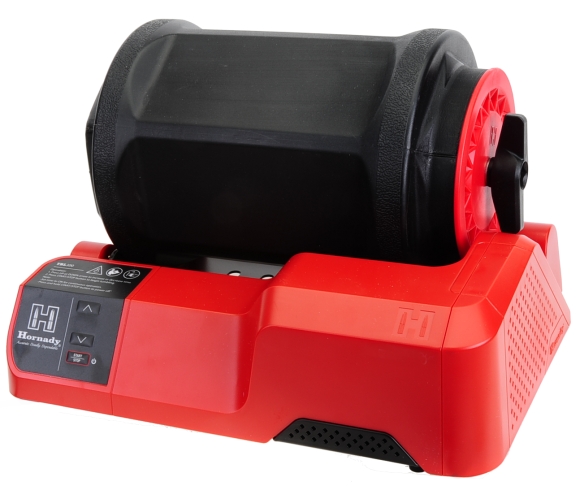
The Hornady Rotary Case Tumbler, in contrast to the previously mentioned competing brand, is low profile, compact even with a six quart drum, features digital controls and minutes display, and has over temp protection. The Hornady site indicates a six liter drum, the instruction manual indicates six quarts. The drum holds six quarts and the difference is not relevant to operation. The Hornady Rotary Case Tumbler is supplied with base, drum with cap and five pounds of stainless steel tumbling media.
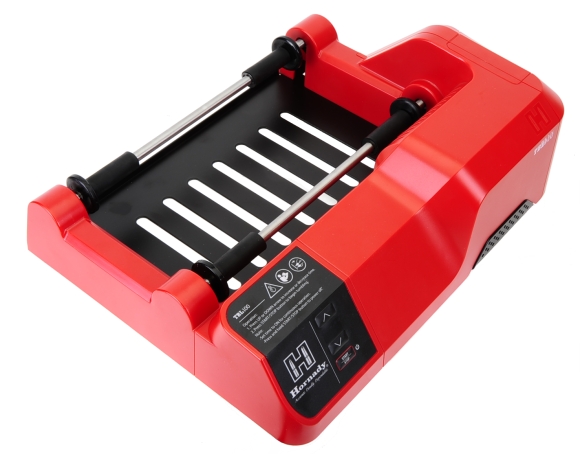
The base is a covered unit containing motor, drive belt and sealed touch control pad and time/power on-off display. The front drum roller shaft is driven, the rear is a support idler. The motor has an overheat protection circuit that will shut the unit down until the motor cools… like if someone, not pointing and fingers here, ignores the seventeen pound gross drum weight constraint and overloads the motor. Overheat cool down takes approximately 30 minutes and is not an occurrence if instructions are followed.
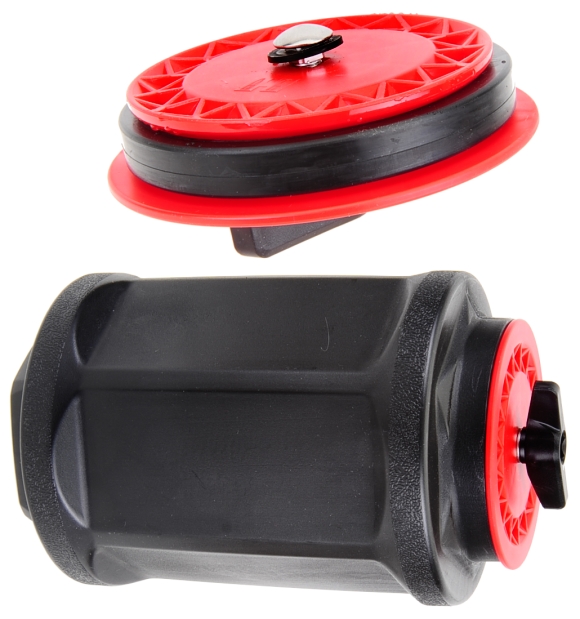
Not, the drum does not have two tops, one of which is giant. That is merely the visual elucidation of the approach Hornady has taken to sealing the drum. The drum has a rubberized interior to dampen noise. The hex forms; body, traction surfaces and both ends is for drum rigidity. The cap is quick release/seal. The seal is a heavy duty pinch gasket that gets squeezed between the two lid halves and expands into the mouth of the drum as the locking knob is tightened.
The five pound, seventeen pound conundrum…
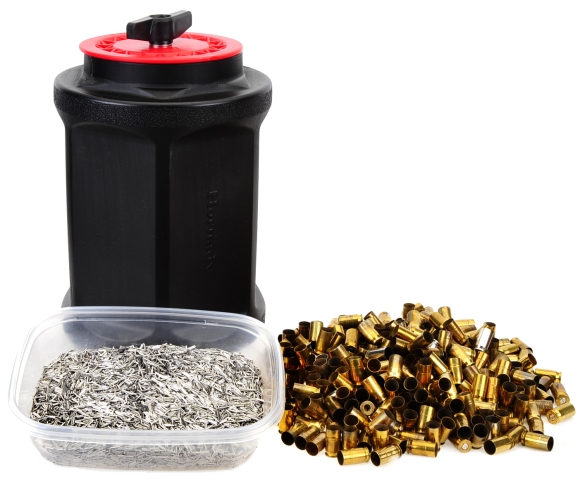
The motor and drive system is rated for a seventeen pound drum load; drum, five pounds of stainless steel pins, five pounds of brass and three quarts of water. In this case, five pounds of brass equates to five hundred 45 Auto.
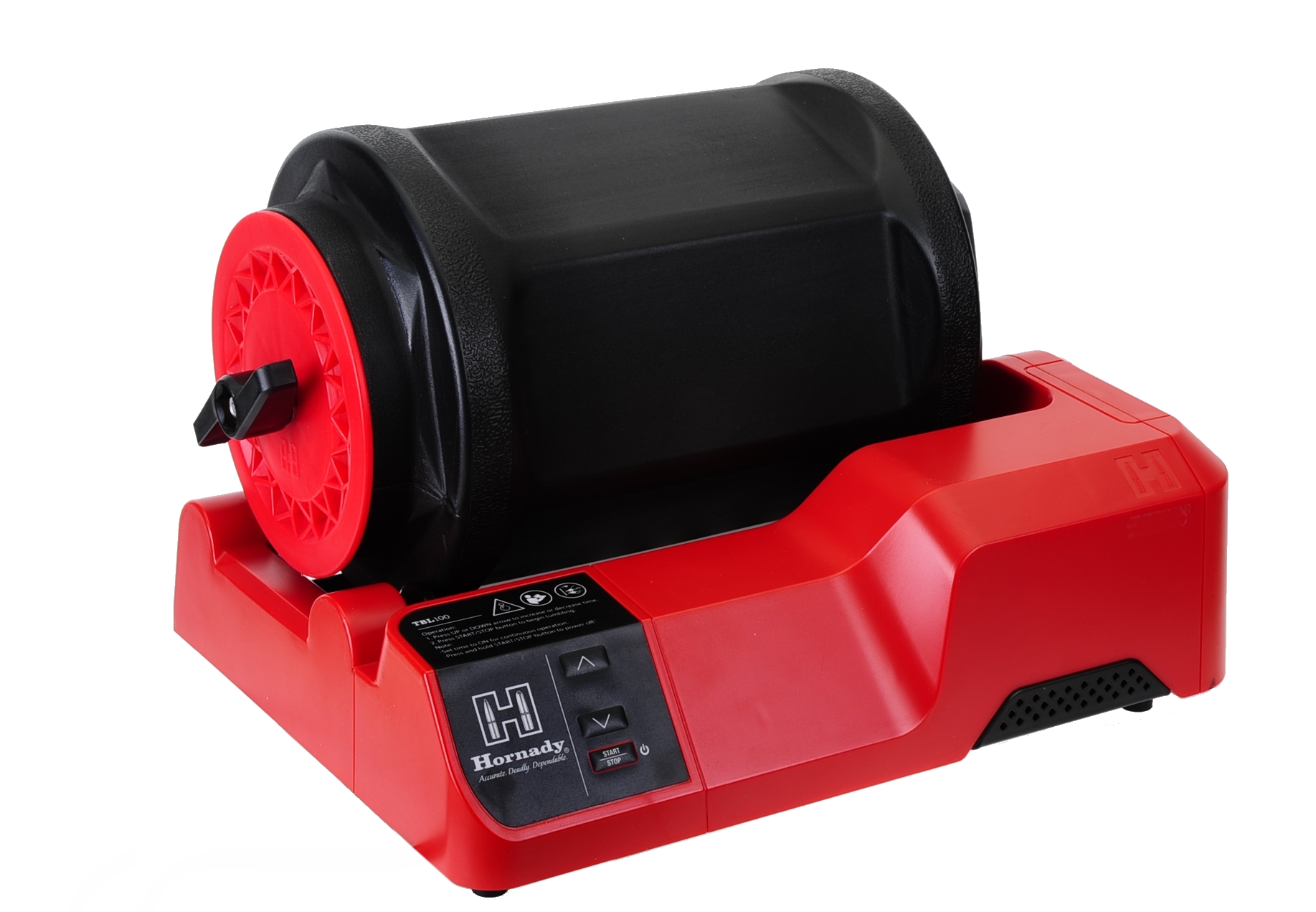
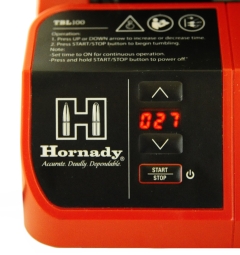 Everything was loaded into the drum; brass, stainless steel pins, three quarts of water and… and, 3/4 ounce of Hornady One Shot Sonic Clean Solution and then the cap was installed. The pins dig away at hardened carbon, interior, exterior and inside primer pockets. The One Shot Solution flushes away surface carbon and whatever the pins loosen.
Everything was loaded into the drum; brass, stainless steel pins, three quarts of water and… and, 3/4 ounce of Hornady One Shot Sonic Clean Solution and then the cap was installed. The pins dig away at hardened carbon, interior, exterior and inside primer pockets. The One Shot Solution flushes away surface carbon and whatever the pins loosen.
The timer was set for one hour, so here it is with 27 minutes left. I did not check in the interim, but at an hour the cases were spotless and bright. It may be that only half that time was required. It was notable that while the steel pins clean aggressively, they did not beat up the brass at all, including case mouths and rim flats. A long stint in a vibratory cleaner, or multiple cycles, will often excessively round rim edges.
I had to play with the lid a bit to stop seepage. The instructions were to tighten the locking knob on the lid, but not too tight and not too light. Three attempts and then a tight seal became routine.
Recovering brass and stainless pins – the Hornady Rotary Media Sifter
If you’ve worked with stainless steel pins as tumbler medium you know they can be elusive little critters and end up in the least expected places. It is possible to empty the drum contents into a very fine mesh strainer held over a bucket, then pull the brass from the strainer while flushing with water. It is possible to use a coarse mesh strainer and let the stainless steel pins flush through into bucket while rinsing the brass. It is also possible that I will eat kale. The easiest way to process post tumbled brass is with a media separator.

The unit is comprised of a base, top and bottom sifter drum with locking rotator handle and a translucent lid to prevent the operator from getting spritzed while cranking this large lettuce spinner.
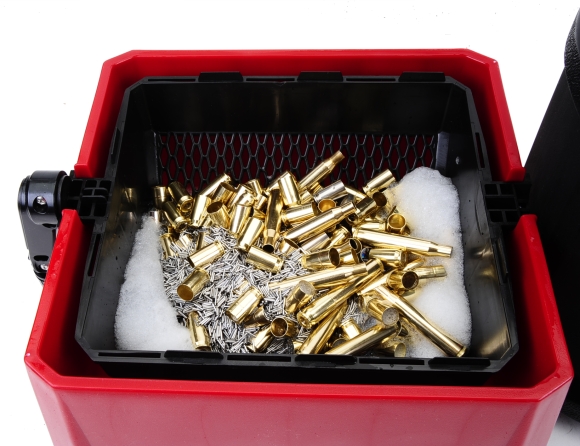
There are several approaches possible when it comes time to empty the Rotating Tumbler’s drum as outlined in the media sifter’s instructions. The following proved to be the easiest for me. Pulling the lid off the drum, excess liquid was poured off into a pail, which left brass, pins and balance of solution in the drum. The balance of the tumbler’s drum contents were then dumped into the sifter’s bottom sifter drum. The brass was clean inside, outside and in primer pockets, but in need of a rise and pin separation. Some 280 Remington brass had been added to the 45 Auto brass in the tumbler drum so I could assess bottle neck case cleaning.
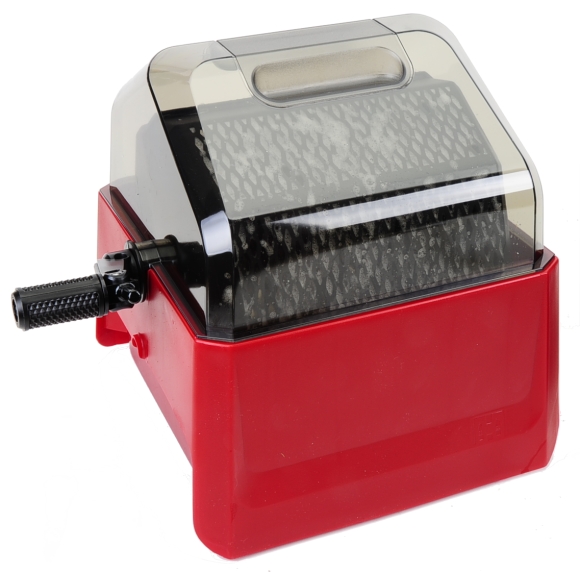
Then the handle was cranked like crazy for maybe 20 – 30 seconds. I was able to see when the pins stopped flying around and had fallen to the bottom of the base. The basket was pulled and brass was rinsed under a faucet with cold water. The base with pins was dumped into a fine mesh screen included with the sifter and that, with steel pins enclosed, was rinsed. The wet brass could have been left out to air dry, but I elected to put it into a brass dryer to expedite the drying process.
Why use a rotary tumbler when cases can be dropped in a vibratory cleaner without the clean up mess? Contrary to what some folks say, I’ve never seen a vibratory cleaner that could remove all carbon and tarnish from a case, inside, outside and in primer pockets and leave a polished finish. And where cases even approach this level of clean they have been left in the cleaner for 6 or 8 hours and then chem cleaned for shine. The rotary tumbler can accomplish the same in less than an hour and put less wear and tear on the brass. Hornady One Shot Sonic Clean Solution is citric acid based and biodegradable. The unit is actually quiet compared to a vibratory cleaner and compared to competing tumbler products. For volume reloaders, the process is fast and effective.

The Hornady Rotary Case Tumbler is generally available through discount retailers for $175.99, which puts it at the low end of the rotary tumbler product spectrum. Surprising based on the dated design of competitors’ products. The Hornady Media Sifter, at $36.49, is price wise is in line to slightly less than competitors. Now I can start digging through tons of brass that has been waiting to be cleaned.

Email Notification